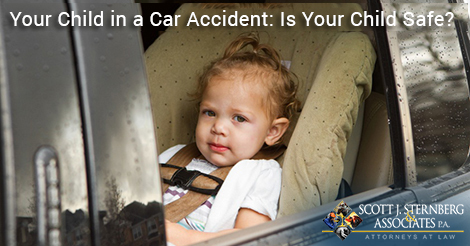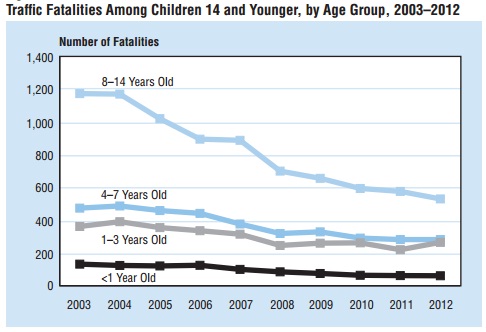Children make up about 19 percent of the total population in the United States. Child deaths in car accidents make up only about 3 percent of all car accident deaths.
However, sadly car accidents are the leading cause of death for children age 4, and every age between 11 and 14. On average, there are three children killed every day in the United States because of vehicle accidents while another 462 are injured.
Download a PDF version of Your Child in a Car Accident: Is You Child Safe?
The Effectiveness of Child Restraints
The lap/shoulder seat belt, when used properly, can reduce the risk of fatal injuries to front-seat passengers 5 and older by 45 percent. It can also decrease the risk of moderate-to-fatal injury by 50 percent. These numbers are even higher in light trucks.
Car seat use reduces the risk of fatality for infants by a staggering 71 percent. It reduces that risk for toddlers by 54 percent. Booster seats can also increase the effectiveness of a lap/shoulder belt by about 45 percent.
A study done by the United States Center for Disease Control of 618,000 children indicated that these children rode in vehicles without the use of a child safety seat or booster seat at least some of the time. Of the children who died in 2013 in car accidents, 38 percent were not buckled up.
Using the Correct Car Seat or Booster Seat
Many parents or caretakers are unaware of the proper positioning and use for car seats and booster seats. Without this proper positioning, many of these safety precautions will be completely ineffective.
Below is a quick overview of the proper seat for every age:
- Rear-facing Car Seat: Until age two, your child should be sitting in a rear-facing car seat that is buckled into the seat. You should also pay attention to the weight and height limits of the seat, because those will force your child to upgrade his or her seat as well.
- Forward-facing Car Seat: From ages 2 to 5, your child can sit in a forward-facing car seat that is buckled into the seat. Again, if your child grows out of the seat, you should upgrade to a booster seat.
- Booster Seat: From about age five until your child is large enough for a seat belt to fit properly, he or she should be using a booster seat in any vehicle. The recommended minimum height for a regular lap/shoulder belt is 57 inches tall. Until then, the booster seat will allow the proper placement of the shoulder belt on your child.
- Seat Belt: Even if your child no longer needs a car seat or booster seat, he or she should always use the shoulder/lap belt in every vehicle. The lap belt should lie across the upper thighs (not the stomach), and the shoulder belt should be across the chest (and not the neck).
Having and using the proper safety restraints can help your family avoid the unthinkable disaster of child death in a car accident. Set a good example for children by wearing your seatbelt every time you get in a car.
Car Seats after an Accident
Parents and caretakers may not realize that they should replace their car seat if they are involved in an accident, even a minor one. Car accidents can cause virtually undetectable damage to a car seat that could cause it to fail in a later accident. You should never put your child in a safety seat that is damaged or otherwise broken.
There are some seats that may not need to be replaced, but they are rare. Check the directions or owner’s manual that accompanied the car seat for more information.
Getting Medical Attention after a Car Accident
Even if your child says they are fine, take them to your doctor or the hospital. Neck and back pain and damage my not show for some time after a car accident and your child may not know how to describe the pain. Go to the doctor your child’s long term health is worth it.
Don’t be Afraid to Ask Question
Medical expenses and long term care are a scary reality after a car accident, even more so with children involved. Personal Injury Protection insurance will cover up to $10,000 of your medical expenses but the cost will add up fast in a more serious accident.
Contact a Florida personal injury attorney and ask questions about you rights, they don’t charge fees for consultation and the information and counsel can reduce stress.


